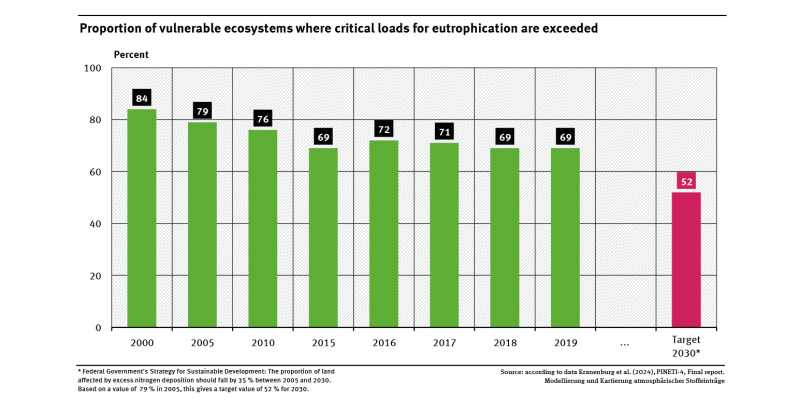Indicator: Nitrogen eutrophication
 Click to enlarge
Click to enlargeSource: according to data Kranenburg et al. (2024) Figure as PDF
 Umweltbundesamt
Umweltbundesamt
 Click to enlarge
Click to enlarge
- 69 % of vulnerable ecosystems in Germany are threatened 2019 by excess nitrogen deposition.
- With the revised German Sustainable Development Strategy 2016, the Federal Government aims to reduce the proportion of these areas by 35 % until 2030. According to the current calculation basis, this results in a target value of 52 % by 2030.
- This target is feasible only if efforts to reduce air pollution are maintained.
The maximum amount of pollutants that ecosystems can tolerate without being damaged is known as the ‘critical load’. It is a measure of an ecosystem's sensitivity to pollution. Air pollution levels above these critical loads can permanently damage ecosystem structures and functions.
Excess deposition of airborne nitrogen compounds in terrestrial ecosystems can cause nutrient imbalances which may modify the species composition. Organisms that prefer low-nitrogen conditions will be displaced in favour of species that thrive in nitrogen-rich habitats.
Almost half of ferns and flowering plants on Germany’s Red List are threatened by nutrient deposition. Moreover, many plants become more susceptible to frost, drought and pests due to changes in nutrient availability. The indicator focuses on natural ecosystems, especially forests, inland marshes, peat bogs, heathlands and nutrient-poor grasslands.
Despite declining nitrogen deposition, in 2019 critical loads were still exceeded in 69 % of the area comprising vulnerable ecosystems. In 2005, this figure was as high as 79 %. High ammonia emissions associated with livestock farming and fertilisation are particularly problematic. These have fallen only marginally and are not expected to decline steeply in the near term.
The Federal Government has set a new target in the revised German Sustainable Development Strategy: The proportion of land affected by excess nitrogen deposition should fall by 35 % between 2005 and 2030 (BReg 2016). With the current calculation basis, this results in a target value of 52 % in 2030. To reach this target, the reduction commitments for ammonia and nitrogen oxides specified in the EU Directive 2016/2284 on the reduction of national emissions of certain atmospheric pollutants” have to be met. These commitments provide for a reduction by 29 % (NH3) and 65 % (NOx) compared to the reference year 2005. The measures that are suitable to reduce these emissions are portrayed in the national air pollution control program, according to the directive.
The German Environment Agency proposes measures aimed at solving the problem of nitrogen eutrophication in its publication ‘Reactive nitrogen in Germany’ (UBA 2015).
The first stage is to calculate critical loads for vulnerable ecosystem types: How much nitrogen can be deposited without damaging the ecosystem in the long term? The critical loads are compared with substance depositions in the ecosystems which are calculated in the framework of national deposition modelling. Further information can be found in the reports of the European Environment Agency and the Federal Environment Agency (EEA 2014, UBA 2014 in German only). As part of the reporting on the National Biodiversity Strategy, a related indicator is published (BMUB 2015, in German only. Due to different methods, this indicator comes to different values.
More detailed information: 'Überschreitung der Belastungsgrenzen für Eutrophierung' (in German only).